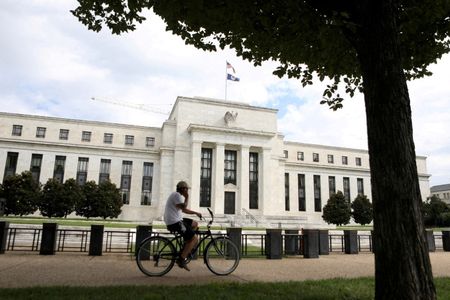(This Sept. 13 story refiles to clarify description of efficiency ratio in second paragraph)
By Mehnaz Yasmin
(Reuters) – Wall Street banks look set to report better efficiency ratios in the second half of the year, a key metric that deteriorated as global economic gloom sapped income from traditional profit centers and costs surged amid a battle for talent, analysts say.
A closely-watched measure of performance, the efficiency ratio is calculated by dividing a bank’s operating expenses by its revenue. A lower efficiency ratio indicates better performance.
“Our current projections assume a modest improvement in the banking industry’s efficiency ratio from just under 58% in 2021 to just under 57% in 2022,” said Christopher McGratty, Head of U.S. Bank Research at KBW, a Stifel company.
The expectation of a marginal recovery in the profit metric foreshadows an uptick in overall revenue growth.
Even though capital markets activity has slowed dramatically, net interest income growth is accelerating, McGratty said, adding that overall revenue growth should exceed expense growth.
For the first six months, the efficiency ratio of JPMorgan leapt to 60% while Citigroup’s jumped to 66%, both highest since 2014, according to earnings presentations. Analysts widely consider a range between 50% and 60% as optimal for banks, and see rising efficiency ratios as a negative sign.
During the same period, Morgan Stanley reported a ratio of 71%, the highest since 2019, while Goldman Sachs and Wells Fargo reported 62% and 77%, the highest since 2020. Early this year, Goldman had set a goal of 60% while Morgan Stanley aimed to stay under 70%.
While Bank of America’s efficiency ratio improved in the first six months this year to 67% from 69% a year ago, the current figure is still 9.5 percentage points higher than that in 2019, before the pandemic struck.
Citigroup, Goldman Sachs, JPMorgan, Morgan Stanley and Wells Fargo declined to comment. Bank of America did not respond to a request for comment Monday. U.S. banks will report third-quarter results starting Oct. 13.
Banks saw efficiency ratios deteriorate this year as profits dwindled in the first two quarters primarily with investment banking activity receding from records set last year. Additionally, a rapid rise in mortgage rates and decline in major stock and bond indices have hammered wealth and asset management businesses and their associated income streams.
As a result, banks were compelled to pursue other fee-generating businesses “to help diversify their income streams, while also offsetting loan demand issues,” said Simon Powley, head of advisory and consulting at Diebold Nixdorf.
In tandem, expenses have been driven upwards by salaries and benefits, he added.
To rein in costs, banks including JPMorgan and Wells Fargo have cut staff in recent months while Goldman Sachs plans to cut jobs as early as this month after pausing the annual practice for two years during the pandemic, according to a source familiar with the matter.
“Banks were among the worst-performing sectors in the second-quarter earnings season as revenue growth was meager and profit decline was significant,” said Jason Benowitz, senior portfolio manager at Roosevelt Investments. “We expect some modest improvement from this low level in the third quarter.”
(Reporting by Mehnaz Yasmin in Bengaluru; Editing by Megan Davies and Nick Zieminski)













